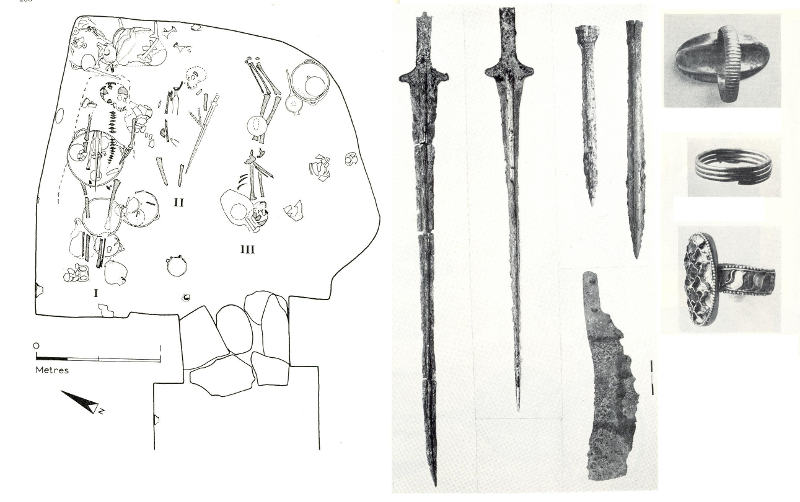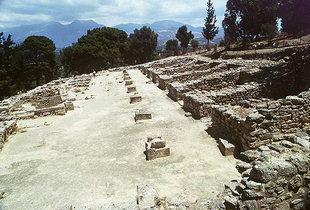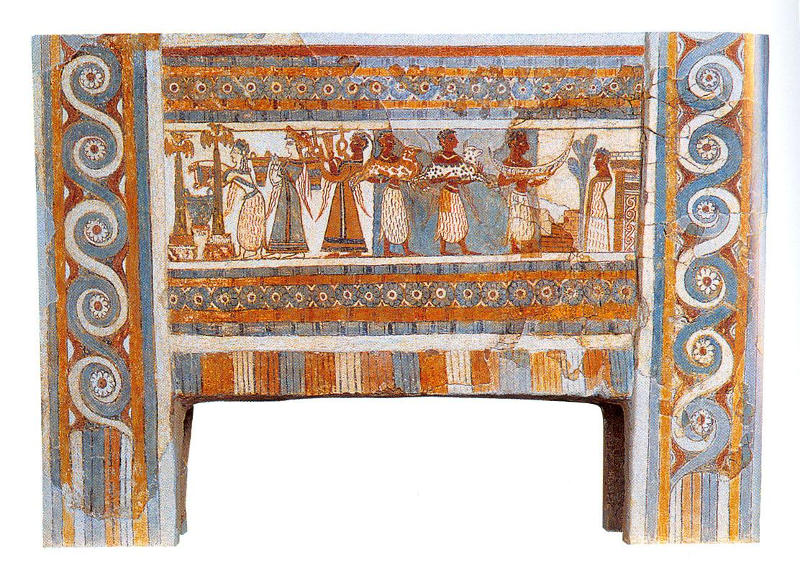| HOME | | | FLORENCE | | | ROME | | | CRETE | | | EDUCATIONAL |
Late Minoan II-III / Mono- and postpalatial period
|
During the first half of the XV century (conventionally 1450 BC) all the Minoan sites with an administrative center ( palaces, villas, rural centers, etc.) are destroyed, with the exception of the Knossos palace. The most likely hypothesis considers the rise to power in the island by Mycenaeans of the continent - we recall the possible weakening of the Minoan fleet and the reduction of the radius of action of Knossos during LM IB. |
|||
|
Mycenaean rulers are at this point able to compete with Minoans and the Knossos palace transforms in a Mycenaean center, as it can be argued mainly from the shift from Linear A to Linear B (Mycenaean) in the writing of administrative documents (FIG. 1: one of the famous "chariot tablets") but also from changes in the shape of the graves - Mycenaean tholos and chamber tombs appear -, in the grave-goods where weapons are prevailing, as it is typical of the Mycenaean grave-goods in the continent (FIG. 2: Sellopoulo, Tomb 4) and in the pottery style (FIG. 3: a large three-handled "palace style" jar). Some changes are certainly carried out in the use the Knossos palace, like for instance the role of the “throne room”, but the palace maintains its preceding structure, quite different from that of the smaller Mycenaean palaces built only later and surrounded, at least in the continent, by cyclopean walls. |
 Fig. 1 - Tablet for administrative use |
 Fig. 2 - Sellopoulo tomb |
 Fig. 3 - Three-handled jar |
|
The administration system of the neopalatial period, characterized by the large residences spread in the island, disappears but it seems that the Knossian power, now in the hands of Mycenaeans, extends to some of the most important sites of the island, where Mycenaean administrative functionaries are displaced. We are finally in a position to know the Knossos administration system, since we are able to read the linear B tablets, a precluded possibility for the Minoan period since Linear A has not been deciphered yet. Trade with Egypt is still going on and is in the hands of Crete while the Mycenaeans of the continent start, without interferences, extending their trade exchanges both in the Near Eastern areas and in Anatolia. This period, including the Late Minoan II-IIIA1 and also called "monopalatial" since the other preceding Minoan palaces are not rebuilt, ends abruptly around 1370 with the destruction of the Knossos palace. An isolated and confined destruction - some parts of the palace and the surrounding town as well are not affected - was probably carried by the joint action of the other Cretan sites and of Mycenaeans of the continent, who could not willingly accept the supremacy of the Mycenaean kingdom of Knossos. Following this event, not only a decline of the civilization in Crete is not observed but rather the other sites of the island where Minoan and Mycenaean elements seem to live together thrive again. The largest part of the pottery findings of the Florentine collection should be ascribed just to this second period. |
|||
 Fig. 4 - Agora of Haghia Triada |
 Fig. 5 - Frescoed sarcophagus |
 Fig. 6 - Stirrup jars with linear B inscriptions |
Haghia Triada becomes one of the most important centers: in place of the Minoan villa a great Mycenaean megaron flourishes and in the lower part of the town the so called Mycenaean agora (FIG. 4), a wide open rectangular space, with alternating pillars and columns, flanked by small rooms (likely store-houses/shops), is built. The famous frescoed limestone sarcophagus (FIG. 5), found in the necropolis next to the town, belongs to this period. The harbour of Kommos, certainly connected to Haghia Triada, still represents one of the main landing of the island, together with the ports of Zakro, to east, and of Chania, to north-west. The finding in this latter site of linear B tablets and of handicrafts consisting of stirrup jars with linear B inscriptions, which were exported to Thebes (FIG. 6), Eleusis Mycenae and Tiryns - at least these are the sites where they were found - denote the connection of this site with the Mycenaean palaces of the continent, a connection probably extending also to a good part of the island. |
|
At variance with Greece, the transition between this period, also defined postpalatial (TM IIIA2- IIIB), seems to occur without heavy upheavals or extended destructions, even though the foundation of new sites in high elevations and the abandonment of several sites seems to be the counterpart of the continental events. |
|||